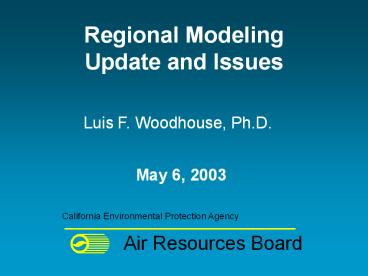Regional Modeling Update and Issues PowerPoint PPT Presentation
Title: Regional Modeling Update and Issues
1
Regional ModelingUpdate and Issues
Luis F. Woodhouse, Ph.D.
- May 6, 2003
2
Emissions and Meteorology
Regional Modeling
Microscale Modeling
Integrated Results
Risk Assessment
Mapping and Visualization
3
Outline
- Review of last meeting
- Regional modeling update
- Model evaluation
- Comparison with previous studies
- Integrating microscale and regional modeling
- Future analysis
- Future statewide modeling considerations
3
4
Review of Last Meeting (September 12, 2002)
- Previous studies
- UAM and CAMx with Carbon Bond IV
- Select toxics
- Small domain
- Present study
- CALGRID and CMAQ with SAPRC99
- Over 30 toxics
- Large domain
- Note CAMx not used since its implementation
mechanism software is not publicly available
4
5
Toxics
- 1,3-butadiene
- Formaldehyde
- Acetaldehyde
- Acrolein
- Benzene
- Carbon tetrachloride
- Chloroform
- Dichloromethane
- 1,2-Dichloroethane
- o-Dichlorobenzene
- p-Dichlorobenzene
- Ethylene oxide
- Styrene
- Toluene
- Vinyl Chloride
- Xylenes
- Hexavalent Chromium
- Diesel PM10
- PM10 Arsenic
- PM10 Beryllium
- PM10 Cadmium
- PM10 Lead
- PM10 Manganese
- PM10 Mercury
- PM10 Nickel
- PM10 Zinc
5
6
Ventura
San Bernardino
Los Angeles
Riverside
Orange
San Diego
93,264 km2 87 x 67 grids (4 km x 4 km)
Mexico
Regional Modeling Domain
Regional Modeling Domain
6
7
Model Inputs
- Emissions
- SCOS97 adjusted to 1998
- seasonal inventories (weekday/weekend)
- latest profiles, surrogates, and EMFAC2000 (with
DTIM4) - Meteorology
- CALMET diagnostic model using data from over 200
sites - MM5 prognostic model
- Boundary conditions
- same for each month, based on SCOS97
7
8
Regional Modeling Update
- CALGRID
- January 1 to December 31, 1998
- CMAQ
- January, April, August and November 1998
8
9
Model Performance
- Verify models ability to reproduce measured
concentrations - Ozone Performance standards are well established
- Toxics No established performance standards
9
10
Model PerformanceConclusions
- Iterative process is needed to improve ozone
performance - In general, model predicted annual average toxics
concentrations are comparable with observations
for most species - Results comparable with previous studies
10
11
Ozone Model Evaluation
- Compared daily ratios of model-predicted to
measured maximum ozone concentrations - CALGRID closer to observations
- CMAQ over predicts
11
12
Ozone Model Evaluation (cont.)
- Calculated daily average gross errors
- Measure models overall ability to reproduce
observed hourly ozone at each site above a
specified threshold concentration - Iterative process
12
13
Toxic VOCs Model Evaluation
- Annual average concentrations
- In general, model predictions are comparable with
the measured annual concentrations for most
toxics VOC species - Some species are significantly under predicted by
both models carbon
tetrachloride, chloroform, ethylene chloride,
styrene
13
14
Annual Averages of Toxic VOCs
14
15
Annual Averages of Toxic VOCs
15
16
Annual Averages ofInert Toxics
- Diesel PM10
- Model predictions are comparable to observed
elemental carbon results - Hexavalent Chromium
- Model predictions are below detection limit
- PM10 components
- Performance depends on species
16
17
Annual Average of Inert Toxics
17
DIES in ug/m3 compared to elemental carbon
18
Annual Average of Inert Toxics
18
DIES in ug/m3 compared to elemental carbon
19
CALGRID (1998)
Diesel PM10
Benzene
ppb
µg/m3
19
20
Comparison withPrevious Studies
- MATES II
- April 1998 to March 1999 field study
- Models
- UAM and recently CAMx
- Carbon Bond IV reaction mechanism
- Our results are comparable
20
21
Comparison with MATES IIBenzene
21
22
Comparison with MATES II Diesel PM10 vs.
Elemental Carbon
22
23
Comparison with MATES II Formaldehyde
23
24
Integrating Microscale and Regional Modeling
Results
- Microscale modeling estimates near source impacts
(meters) - Regional modeling estimates impacts from sources
in a large area (km) - Issue
- double-counting
24
25
Barrio Logan Modeling Results
DIESEL PM10
ISCST3 CALINE CALGRID
BARRIO CHULA EL
-----------BARRIO LOGAN-------------- LOGAN
VISTA CAJON
25
26
Barrio Logan Modeling Results (cont.)
BENZENE
ISCST3 CALINE CALGRID
BARRIO CHULA EL
-----------BARRIO LOGAN-------------- LOGAN
VISTA CAJON
26
27
Barrio Logan Modeling Results (cont.)
HEXAVALENT CHROMIUM
NA
ISCST3 CALINE CALGRID
BARRIO CHULA EL
---------BARRIO LOGAN-------------- LOGAN
VISTA CAJON
27
28
Sensitivity Simulations Double Counting
- In Barrio Logan, local emissions contribute less
than 1 of the annual average concentration of
most toxic species. - In Wilmington, local emissions contribute
15-90 of the annual average concentrations - Benzene (47)
- Diesel exhaust (40)
- 1,3-butadiene (16)
28
simulations for all 1998 were done in each case
with CALGRID
29
Sensitivity SimulationsBarrio Logan
- Changing boundary conditions has very small
impact on annual average toxic concentrations - Choosing different averaging periods
- 12-month average toxic concentrations can be
significantly different from 4-month average
concentrations - 4-month average cumulative risk is about 10
higher than the 12-month average cumulative risk
29
30
Future Analysis
- Improve estimates of background toxic
concentrations - Omit all toxics emissions in a cell
- Omit toxic emissions from selected categories in
a cell - Evaluate procedures for estimating contributions
of secondary species - Evaluate deposition effect
- Run CALGRID using MM5 winds
- Conduct spatial analysis
30
31
Future Statewide Modeling Considerations
- Air quality model selection
- CALGRID, CMAQ, CAMx, other
- Atmospheric reaction mechanism
- Run time (e.g., CALGRID with SAPRC99 and 4 km x 4
km grids, at least 6 months) - Period simulated
- Every day in a year or selected episodes
31
32
Future Statewide Modeling Considerations (cont.)
- Input preparation
- Emissions
- Meteorology (CALMET, MM5)
- Other considerations
- Baseline year
- Multiple year simulation
- Storage requirements
32

